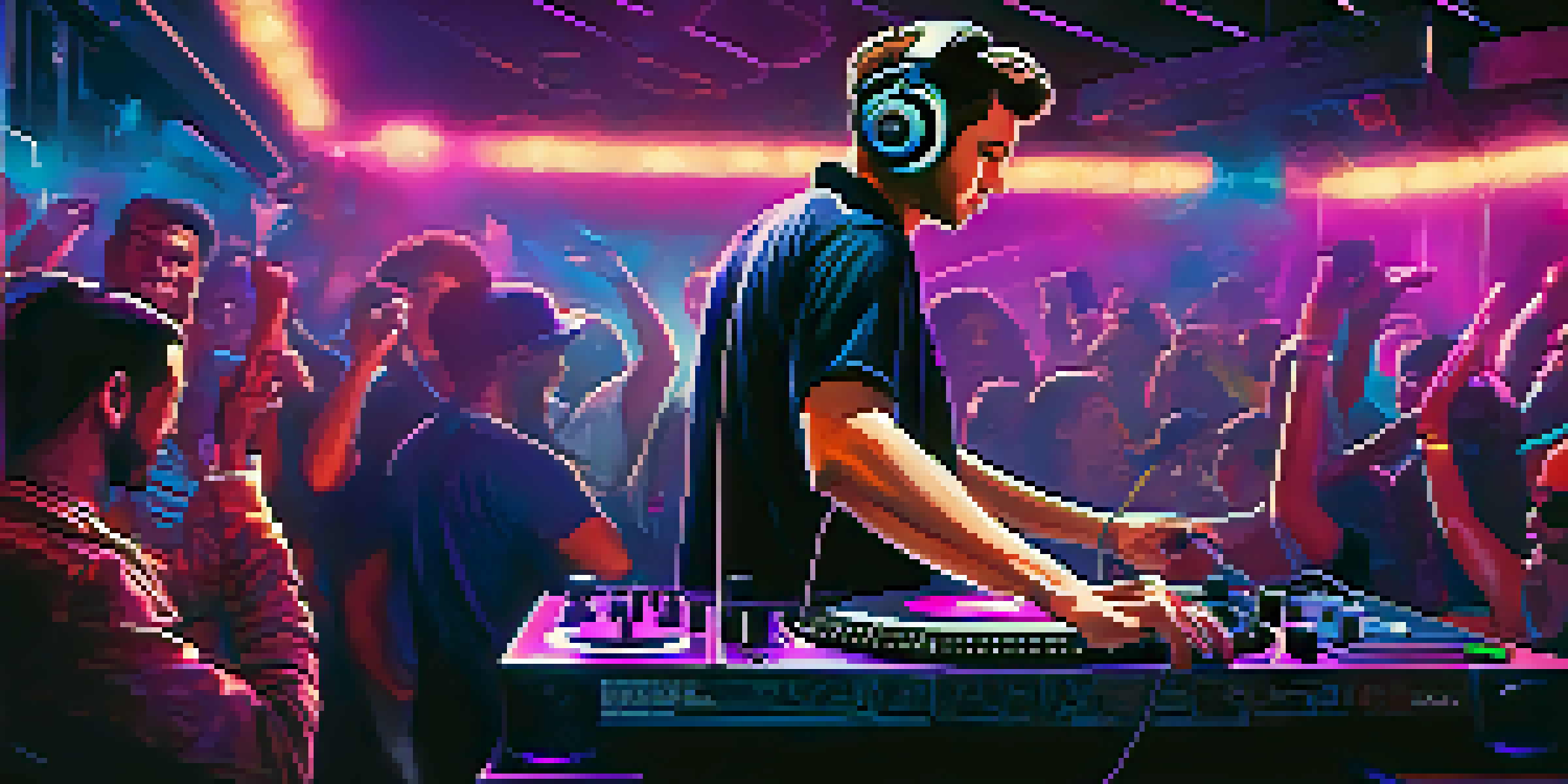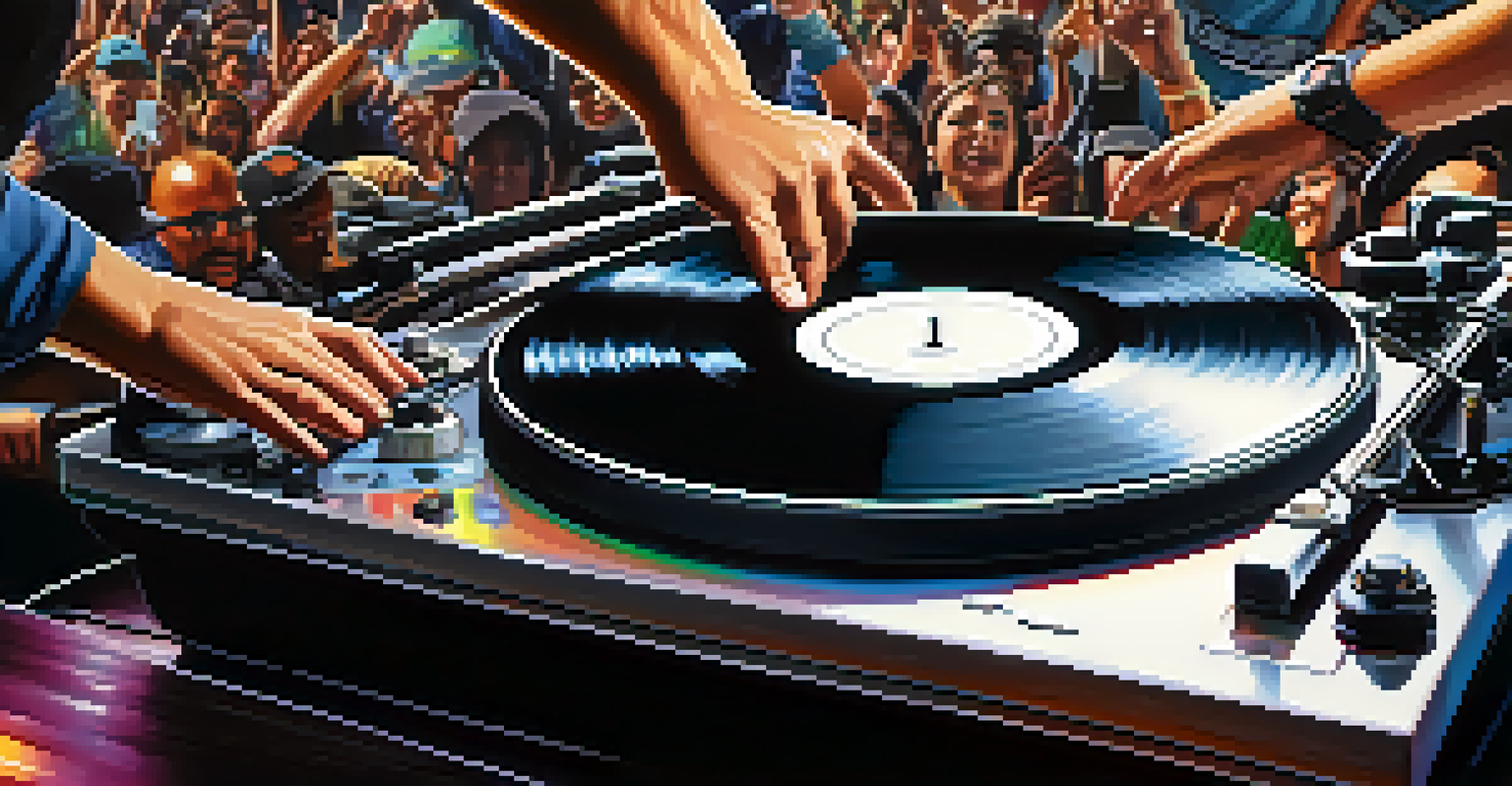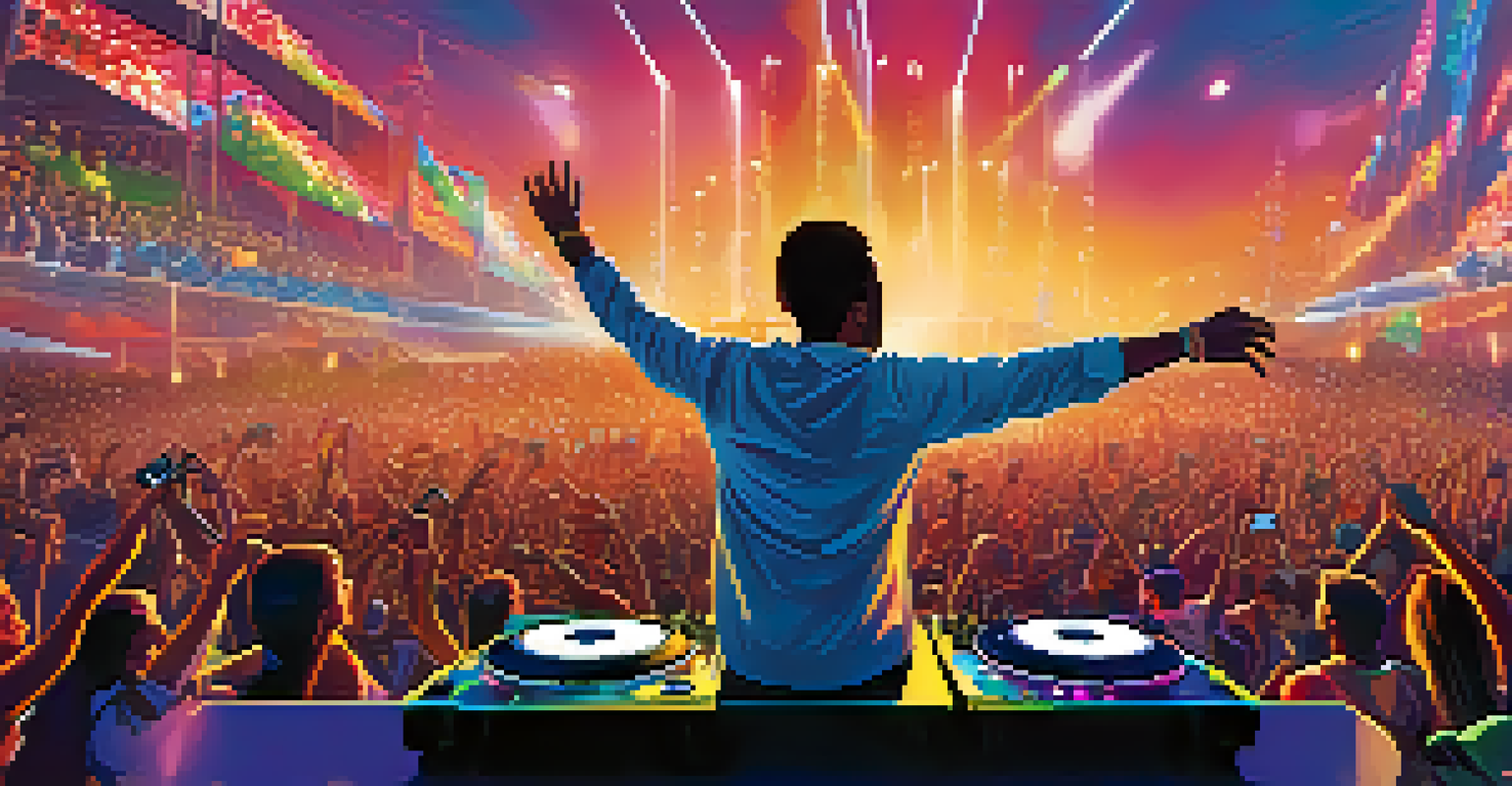DJing Genres: Understanding Different Styles of Mixing

What is DJing? The Art of Mixing Music
DJing is more than just playing songs; it's an art form that involves mixing various tracks to create a seamless audio experience. At its core, DJing combines different genres, tempos, and styles to engage an audience. Whether you're at a club, a festival, or a private party, the DJ's job is to keep the energy flowing and the crowd dancing.
DJing is the ultimate expression of creativity and connection, merging music with the energy of a live crowd.
A DJ uses a variety of techniques, such as beatmatching and blending, to ensure that the transitions between songs are smooth. This requires a keen ear for rhythm and the ability to read the crowd's energy. The right mix can elevate a party atmosphere, turning an ordinary night into an unforgettable experience.
Understanding the fundamentals of DJing is essential for anyone looking to dive into this vibrant world. From selecting the right tracks to mastering the equipment, every detail contributes to the overall performance. As we explore different DJing genres, we'll uncover how each style influences the mixing techniques used.
House Music: The Foundation of Modern DJing
House music is often considered the backbone of modern DJing, emerging from Chicago in the 1980s. Characterized by its four-on-the-floor beat and repetitive lyrics, house music sets the stage for creative mixing. The genre's infectious rhythm encourages DJs to experiment with layering tracks, creating a unique sound that resonates with the audience.

DJs often blend different sub-genres of house, such as deep house and tech house, to add variety to their sets. This versatility allows for a dynamic performance that can adapt to the crowd’s mood. For instance, a deep house track might evoke a chill vibe, while a tech house tune can ramp up the energy.
DJing is an Art Form
DJing involves mixing various tracks and engaging the audience to create a seamless audio experience.
Mastering house music's nuances equips DJs with the skills to keep the dance floor alive. With its rich history and evolving sound, house music remains a favorite among both novice and seasoned DJs.
Hip-Hop: The Genre of Rhythm and Rhyme
Hip-hop is a genre that thrives on creativity and rhythm, making it a playground for DJs. Originating in the Bronx in the 1970s, hip-hop combines beats, lyrics, and scratching techniques to create a unique auditory experience. DJs play a crucial role in this genre, often using turntables to mix classic tracks with contemporary beats.
Music is a world within itself; it’s a language we all understand.
The art of sampling is a fundamental aspect of hip-hop DJing, where DJs take snippets from existing songs and incorporate them into new mixes. This not only showcases their creativity but also pays homage to the artists who came before them. The ability to seamlessly blend different samples can turn a good set into a great one.
Engaging with the crowd is vital in hip-hop DJing, as the genre encourages interaction and energy. A skilled DJ knows when to drop a familiar track to ignite excitement, ensuring everyone feels part of the performance.
Techno: The Pulsating Beat of the Underground
Techno music is characterized by its repetitive beats and synthesized sounds, often creating an immersive experience for listeners. Emerging from Detroit in the 1980s, techno emphasizes rhythm and texture, allowing DJs to explore intricate mixing techniques. The genre’s hypnotic quality draws audiences into a trance-like state, making it a favorite in underground clubs.
DJs often use long mixes in techno to gradually build intensity, transitioning between tracks with minimal interruption. This requires a deep understanding of the tracks being played and the ability to anticipate the crowd's response. Effective mixing in this genre can turn a simple set into a captivating journey through sound.
Genres Shape DJing Techniques
Different music genres, like house and hip-hop, influence mixing styles and techniques, allowing DJs to adapt their performances.
The culture surrounding techno is also significant, with many events embracing a sense of community and connection. DJs in this genre often feel a responsibility to create an atmosphere that reflects these values, making their sets not just about music, but about experience.
Drum and Bass: Fast-Paced Energy on the Decks
Drum and bass (DNB) is known for its fast tempo and heavy bass lines, making it a high-energy genre that demands skillful mixing. Originating from the UK in the early 1990s, DNB combines elements of jungle and techno, creating a unique sound that captivates listeners. DJs who specialize in this genre need to be quick on their feet, as the tempo often ranges from 160 to 180 BPM.
The rapid pace of DNB allows for exciting mixing opportunities, such as quick cuts and dynamic transitions. A skilled DJ can keep the audience engaged by seamlessly switching between tracks, maintaining a high level of energy throughout the set. This style of mixing requires practice and a deep familiarity with the genre's intricacies.
Moreover, DNB often incorporates diverse influences from other genres, allowing DJs to showcase their creativity. By blending different styles, DJs can craft a unique sound that keeps the crowd on their toes and eager for more.
Dubstep: The Bass-Heavy Revolution
Dubstep emerged in the late 1990s as a genre that focuses heavily on bass and rhythmic complexity. With its signature wobbles and drops, dubstep has become a defining sound in electronic dance music. DJs who specialize in this genre often use dramatic transitions to enhance the listening experience, keeping the audience engaged through surprising shifts in tempo and intensity.
The mixing techniques in dubstep often highlight the genre's unique soundscapes, allowing DJs to play with dynamics and textures. A well-timed drop can send a crowd into a frenzy, demonstrating the power of effective mixing. DJs need to master the art of building anticipation and delivering the punch when it counts.
Find Your Unique DJ Style
Exploring various genres helps DJs discover their personal sound, leading to emotionally impactful performances.
Furthermore, dubstep's crossover appeal has led to collaborations with various artists and genres, broadening its reach. This versatility allows DJs to experiment with different sounds, creating a diverse set that resonates with a wide audience.
Electro: Blending Styles for Unique Soundscapes
Electro is a genre that fuses elements from different musical styles, creating a distinctive sound that's both innovative and nostalgic. With roots in the early days of hip-hop and electronic music, electro emphasizes the use of synthesizers and drum machines. DJs working within this genre enjoy the freedom to mix and match influences, crafting sets that are both engaging and eclectic.
The mixing style in electro often involves layering various elements to create rich soundscapes. DJs might blend classic electro tracks with modern beats, resulting in a fresh take on the genre. This approach not only showcases their technical skills but also highlights their creativity.

Electro's vibrant community encourages collaboration and experimentation, making it a favorite among DJs who enjoy pushing boundaries. By embracing diverse influences, electro DJs can create memorable performances that resonate with audiences on multiple levels.
Conclusion: Finding Your Own DJing Style
Understanding the various DJing genres is crucial for anyone looking to carve their niche in the music scene. Each genre offers unique mixing techniques and styles that cater to different audiences and atmospheres. Whether you prefer the infectious beats of house music or the high-energy drops of dubstep, exploring these genres will help you develop your personal sound.
As you experiment with different styles, you'll discover what resonates with you and your audience. This journey of exploration can lead to finding your own voice as a DJ, allowing you to create sets that are not only technically sound but also emotionally impactful.
Ultimately, the beauty of DJing lies in its ability to connect people through music. By embracing the diversity of genres and honing your skills, you can become a DJ who not only entertains but also inspires.